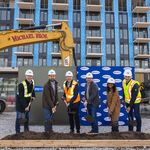G
GregWTravels
Guest
Clicking on the article shows a map, which includes all the high speed rail links they would like to build. The map shows links into Canada at Niagara Falls and Windsor.
Probably will never come to pass...
news.enquirer.com/apps/pb...40397/1077
Train would link Ohio cities
Planners project $3.2 billion high-speed line
BY JON CRAIG | ENQUIRER COLUMBUS BUREAU
COLUMBUS - State officials are promoting - and already planning for - a $3.2 billion high-speed passenger rail line linking Cincinnati to Dayton, Columbus and Cleveland.
"The day the first high-speed passenger trains ... roll into town is not the time to unlock the old depot or break ground for a new train station," said the Ohio Rail Development Commission.
The rail commission, an independent branch of the state Department of Transportation, is hosting a Columbus-area conference today about the proposal for public officials and planners from five states.
It will examine such issues as where to put rail stations, what kind of retail development cities could expect, how rail passenger systems work in New England and elsewhere, and how to do it in the Midwest.
"The No. 1 operative question for the user is: 'Can I get there quicker and more cost-effectively than if I drive?' " said commission spokesman Stu Nicholson.
Nicholson insists that skyrocketing gasoline prices and shifting public attitudes about mass transit are giving his group some steam.
A 2004 study by Transportation Economics & Management Systems Inc. estimated that one-way rail fares between Cincinnati and Columbus would average $50. It would cost $95 one-way between Cincinnati and Cleveland.
Frequent rail users, students, senior citizens and weekend travelers would likely be offered lower fares.
Rail passengers' commuting time can be spent more productively than people traveling across the state by car or air, Nicholson said. They can read, safely make calls or work on laptop computers, he said.
Working against the train enthusiasts: A growing federal budget deficit, competing spending priorities and rising freight train traffic, which would have to share the rail lines.
Is their project pie-in-the-sky?
"That's exactly the question I ask," said Mark Policinski, executive director of the Ohio-Kentucky-Indiana Regional Council of Governments, the area planning agency. "The only way this happens is with a massive federal investment."
If successful, the rail network could extend into West Virginia, Indiana, Illinois, Michigan, Pennsylvania, New York, even Canada.
Nicholson said Ohioans could ride passenger trains on the so-called 3-C corridor - 258 miles of track named after Ohio's three largest cities - within two years of federal funding.
To gain momentum, the state commission has joined a 28-state group working to make passenger rail service a reality. In addition to actively lobbying Congress for money, Nicholson said a federal environmental impact study is planned next year to set the project in motion.
Amtrak figures show only 12,407 people got on and off Amtrak trains in 2005 in Cincinnati - fewer people than used Amtrak in Newton, Kan., or Tukwila, Wash.
But Nicholson suggested more people would use it if it came through town more than twice a week at odd hours.
More freight is carried by rail than ever before, but on fewer miles of track.
Allison D'Aurora of the Columbus Bureau contributed. E-mail jcraig @enquirer.com
Probably will never come to pass...
news.enquirer.com/apps/pb...40397/1077
Train would link Ohio cities
Planners project $3.2 billion high-speed line
BY JON CRAIG | ENQUIRER COLUMBUS BUREAU
COLUMBUS - State officials are promoting - and already planning for - a $3.2 billion high-speed passenger rail line linking Cincinnati to Dayton, Columbus and Cleveland.
"The day the first high-speed passenger trains ... roll into town is not the time to unlock the old depot or break ground for a new train station," said the Ohio Rail Development Commission.
The rail commission, an independent branch of the state Department of Transportation, is hosting a Columbus-area conference today about the proposal for public officials and planners from five states.
It will examine such issues as where to put rail stations, what kind of retail development cities could expect, how rail passenger systems work in New England and elsewhere, and how to do it in the Midwest.
"The No. 1 operative question for the user is: 'Can I get there quicker and more cost-effectively than if I drive?' " said commission spokesman Stu Nicholson.
Nicholson insists that skyrocketing gasoline prices and shifting public attitudes about mass transit are giving his group some steam.
A 2004 study by Transportation Economics & Management Systems Inc. estimated that one-way rail fares between Cincinnati and Columbus would average $50. It would cost $95 one-way between Cincinnati and Cleveland.
Frequent rail users, students, senior citizens and weekend travelers would likely be offered lower fares.
Rail passengers' commuting time can be spent more productively than people traveling across the state by car or air, Nicholson said. They can read, safely make calls or work on laptop computers, he said.
Working against the train enthusiasts: A growing federal budget deficit, competing spending priorities and rising freight train traffic, which would have to share the rail lines.
Is their project pie-in-the-sky?
"That's exactly the question I ask," said Mark Policinski, executive director of the Ohio-Kentucky-Indiana Regional Council of Governments, the area planning agency. "The only way this happens is with a massive federal investment."
If successful, the rail network could extend into West Virginia, Indiana, Illinois, Michigan, Pennsylvania, New York, even Canada.
Nicholson said Ohioans could ride passenger trains on the so-called 3-C corridor - 258 miles of track named after Ohio's three largest cities - within two years of federal funding.
To gain momentum, the state commission has joined a 28-state group working to make passenger rail service a reality. In addition to actively lobbying Congress for money, Nicholson said a federal environmental impact study is planned next year to set the project in motion.
Amtrak figures show only 12,407 people got on and off Amtrak trains in 2005 in Cincinnati - fewer people than used Amtrak in Newton, Kan., or Tukwila, Wash.
But Nicholson suggested more people would use it if it came through town more than twice a week at odd hours.
More freight is carried by rail than ever before, but on fewer miles of track.
Allison D'Aurora of the Columbus Bureau contributed. E-mail jcraig @enquirer.com




